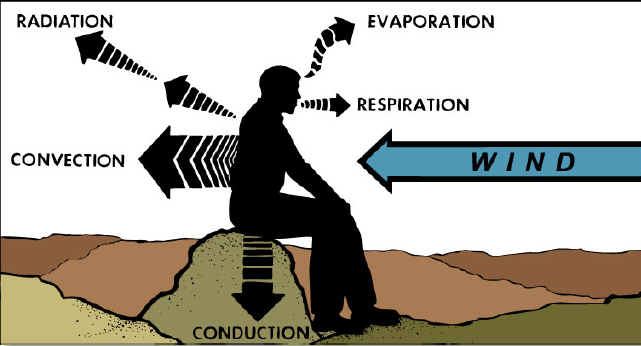Reality Survival
The 5 Methods Of Heat Transfer
The 5 Methods Of Heat Transfer

At its most basic level survival is really all about four things. First is maintaining your security. Second is maintaining your body temperature. Third is maintaining an adequate level of sustenance. And finally last is finding a way to be a part of civilization again. One of the number one killers in a wilderness survival situation is exposure also called hypothermia. A person becomes hypothermic when their core body temperature falls below a level that the body and organs can properly function. Therefore understanding how the body loses heat is imperative! Lets take a look at what the USAF SERE manual has to say about heat transfer.
Body heat can be transferred by radiation, conduction, convection, evaporation, and respiration. Understanding how heat is transferred and the methods by which that transfer can be controlled can help a survivor keep their body's core temperature in the 96°F to 102°F range.
Radiation is the primary cause of heat loss. It involves the transfer of heat waves from the body to the environment and/or from the environment back to the body. For example, at a temperature of 50°F, 50 percent of the body's total heat loss can occur through an exposed head and neck. As the temperature drops, the situation intensifies. At 5°F, the loss can be 75 percent under the same circumstances. Not only is heat lost from the head, but also from the other extremities of the body. The hands and feet also radiate significant amounts of heat. To minimize the amount of heat lost, make sure areas of exposed skin are covered, including the head, face, neck, hands, and feet.
Conduction is the movement of heat from one molecule to another molecule by direct contact within a solid object. Extreme examples of how heat is lost and gained quickly are deep frostbite and third-degree burns, both of which can happen by touching the same piece of metal at opposite extremes of cold and heat. Heat is also lost from the body in this manner by touching objects in the cold with bare hands, by sitting on a cold log, or by kneeling on snow to build a shelter. These are things which a survivor should avoid since they can lead to over chilling the body.
Heat movement by means of air or wind to or from an object or body is known as convection. The human body is always warming a thin layer of air next to the skin by radiation and conduction. The temperature of this layer of air is nearly equal to that of the skin. The body stays warm when this layer of warm air remains close to
the body. However, when this warm layer of air is removed by convection, the body cools down. A major function of clothing is to keep the warm layer of air close to the body; by removing or disturbing this warm air layer, wind can reduce body temperature. Therefore, wind can provide beneficial cooling in dry, hot conditions, or be a hazard in cold, wet conditions.
Evaporation is a process by which liquid changes into vapor, and during this process, heat within the liquid escapes to the environment. An example of this process is how a desert water bag works on the front of a jeep while driving in the hot desert. The wind created by the jeep helps to accelerate evaporation and causes the water in the bag to be cooled. The body also uses this method to regulate core temperature when it perspires and air circulates around the body. The evaporation method works any time the body perspires regardless of the climate. For this reason, it is essential that people wear fabrics that breathe in cold climates. If water vapor cannot evaporate through the clothing, it will condense, freeze, and reduce the insulation value of the clothing and cause the body temperature to go down.
The respiration of air in the lungs is also a way of transferring heat. It works on the combined processes of convection, evaporation, and radiation. When breathing, the air inhaled is rarely the same temperature as the lungs. Consequently, heat is either inhaled or expelled with each breath. A person's breath can be seen in the cold as heat is lost to the outside.
During a wilderness survival situation it is imperative that you constantly evaluate how your body is loosing heat. The primary struggle in any survival situation boils down to your ability to keep your body temperature as close to 98.6 degrees as possible!
Be sure to add me as a friend on Facebook!
http://www.facebook.com/jjatrealitysurvival
Also Like my Facebook Page at: http://www.facebook.com/realitysurvival
And Follow Me On Instagram at: http://www.instagram.com/realitysurvival